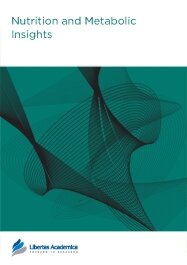

Publication Date: 10 Dec 2008
Journal: Nutrition and Metabolic Insights
Citation: Nutition and Metabolic Insights 2009:2 1-9

1Small Ruminant Comparative Orthopaedic Laboratory, College of Veterinary Medicine and Biomedical Sciences, Colorado State University, Fort Collins, Colorado 80523, U.S.A. 2Independent Consultant, Fort Collins, CO. 3Orthopaedic Bioengineering Research Laboratory, College of Engineering, Colorado State University, Fort Collins, Colorado 80523, U.S.A.
Abstract
Dietary induced metabolic acidosis (MA) results in a negative calcium balance in normal animals. In order to maintain acid-base homeostasis the body’s primary base buffer source calcium is mobilized from bone. This study examined the impact of dietary induced MA on bone in an adolescent ovine model. We hypothesized that a MA diet would reduce bone mineral density (BMD) in growing sheep. Twelve 2 month old lambs of mixed sex were divided into 2 groups. The MA group consumed a ration that was relatively acidogenic compared to the control diet (CD) for 6 months. DXA was performed on days 0 and 180. Arterial blood samples were evaluated on days 0, 30, 120, 150 and 180 for pH, pCO2, pO2, HCT, Na, K, ionized Ca, HCO3−, TCO2, base excess (BE), and O2 saturation. Histomorphometry of the femoral diaphysis was performed from samples harvested at 180 days. Statistical analysis consisted of a 2-way ANOVA for sex and diet with repeated measures for bone mineral content (BMC) and blood parameters, a 2-way ANOVA for one time measurements at 180 d including BMD of the whole body, radii, femora and lumbar vertebrae, and 1-way ANOVA to compare histomorphometric measurements.
Percent increase from baseline for BMD of the whole body was 1.8x greater in the CD group than the MA group. BMC of the whole body and lumbar vertebrae was significantly less in the MA group. Lumbar BMD on day 180 was 30% less in the MA group. Cortical bone was less affected. Radii and femora BMD was 18% and 21% less, respectively, in the MA group than in the CD group. MA treatment significantly decreased pH, HCT, iCa, HCO3−, TCO2 and BE. However, no blood parameters were outside the normal range for this species. Histomorphometry revealed significantly decreased cortical area and thickness and increased mineral apposition rate and endosteal active surface length in the femoral cortex of the MA group compared to the CD group.
This study demonstrated a well compensated dietary induced MA that resulted in a significant decrease in bone mineral acquisition in juvenile sheep. Diets that induce MA may have a profound impact on lowering peak BMD in adolescents and therefore predispose individuals to osteoporosis later in life.
PDF (660.28 KB PDF FORMAT)
RIS citation (ENDNOTE, REFERENCE MANAGER, PROCITE, REFWORKS)
BibTex citation (BIBDESK, LATEX)


We have had a great experience publishing our paper in Nutrition & Metabolic Insights. The peer review process was rigorous and the journal staff were very helpful with proof processing. We will definitely be submitting future manuscripts to this journal. Keep up the good work!!
Facebook Google+ Twitter
Pinterest Tumblr YouTube